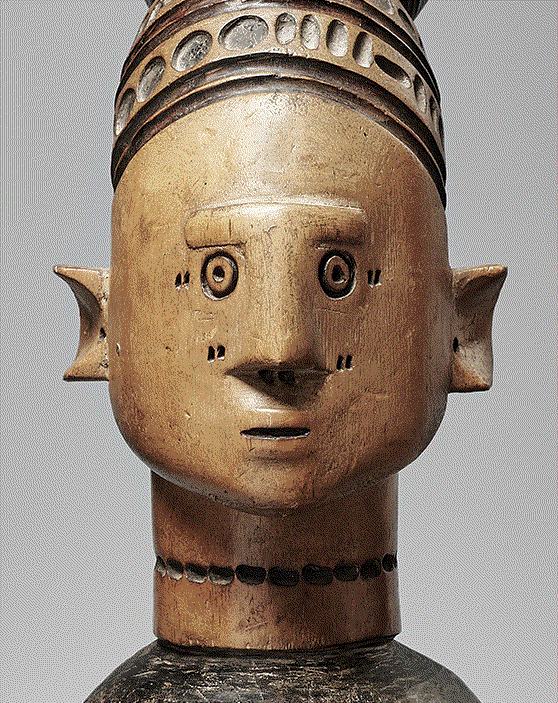
Another African artist who’s name is forever lost, while his style is so personal he at least deserves a “pseudo-name”. For me, the trademark of this artist’s work is the T-shaped brow which links the nose, nasal bone and eyebrows, a feature present in all his works – hence the nickname. All faces also have the same type of scarification (two small parallel lines) next to the (deeply incised) circle-dot eyes and nostrils. On the neck there is an incised necklace, formed by a continious circle of small carved crosses (sometimes rectangles). Other typical features of the work of this carver are the typical ‘halo-like’ coiffure, the pointed breasts with large exagerated nipples, the position of the hands enclosing the navel, the protruding belly button, and the pentagonal base.

Figural art depicting a Mangbetu-style head is still called “Mangbetu” no matter who produced it. Although we can not be sure if “The Master of the T-shaped brow” in fact was Mangbetu or Zande, we do know he was very active in the first decade of the twentieth century. Five figures of this artist are known. One of these figures was brought to Europe in 1925 by E. Lefevre, a Belgian prospector and geologist, and thus carved before this date. A second figure was collected by Ernest Shreiber, magistrate in the Belgian Congo, between 1890 and 1913. One of the three pedestals illustrated below was collected in the 1920s. Another figure was already in Europe in 1902. All other objects by this carver have no information about their date of collection. It is thus plausible that this sculptor started carving in the last decade of the 19th century, when Europeans first entered the region, and developed a more homogenous style throughout the years. This corresponds with the fact that the majority of the figurative sculpture in the Uele region was created between 1908 and 1925.
Three other objects are also part of this artist’s corpus; their function is uncertain. A pedestal surmounted by a classic Mangbetu head, they were most likely prestige objects.

Like most anthromorphic carvings from the Northeastern Congo, the head shows the typical elongation, strenghtened by the receding hairline. Since the Mangbetu spent a great deal of their time on personal appearence, new hairdresses developed all the time. Hairstyles varied considerably throughout time and according to the status, the occasion and even the mood of the wearer. Wealthier people could afford the time to prepare elaborate coiffures. At the end of the 19th century the practice emerged to strenghten this elongating effect of the forehead by embellishing the coiffure with a sort of funnel-shaped conceived halo. The hair was pulled back, sometimes supplemented with hair from other people, and tied into a open chignon at the back, with the help of a disk- shaped framework of reeds that had been woven into the hair. Originally this coiffure indicated a high social position, worn by the ruling lineage. Afterwards it became an ideal of beauty for all those who wanted to make the effort – preparing such a coiffure was very time-consuming. The halo-shaped basketry frame covered with hair only became common and widespread by 1910. For even more elegance, the Mangbetu wrapped the forehead and the front half of the skull with a wide band of carefully juxtaposed, blackened fiber strings – as can be seen on the field-photo below. The horizontal bands of parallel lines on the wooden statues possibly represent these strings.
The function of these figures is highly interesting since it exemplifies the ongoing difficulty to define authenticity in African art. We know that in the colonial period, the European presence greatly expanded the market for certain types of art in the Uele region. Local chiefs commissioned objects for the Western visitors; they mediated between the new patrons and local artists and encouraged artists to produced the kinds of works that Europeans admired. Chiefs of northeastern Congo thus employed artists to carve anthropomorphic figures, some of which were given as gifts to other leaders, both African and European. These gifts were all the more necessary in uncertain times, as in the period of Arab and European contact. The era of colonial rule threatened the continued operation of the traditional Mangbetu court system. This practice of using art as a form of tribute encouraged the development of workshops in which rulers employed carvers who worked in distinctive styles – such as the one under discussion here. These statues thus were made for secular rather than religious purposes, and in a way are early Congolese examples of sculpture carved intentionally to be a works of art. As Schildkrout and Keim wrote in their excellent book on the subject (African Reflections, American Museum of Natural History, 1990), many of the arts that flourished in the very early colonial period gradually died out in the years after the death of chief Okondo (in 1915) and other rulers. Administrative changes were rapidly reducing the formal power of chiefs. Once the system of colonial rule became firmly established, chiefs were less inclined to use art to win the favor of colonial officials. With the Belgian bureaucratization of colonial administration, gifts of art became less useful as a means of communicating with the colonial authorities. Once the patronage of chiefs was gone, the quantity and quality of anthropomorphic art decreased dramatically. Depending on one’s definition of ‘authenticity’, one can thus place this type of sculpture in one or the other category. Surely these statues were employed in a post-contact environment and did not have any religious or magical use, still, as we have seen above, they served a very specific use to their commissioners…
